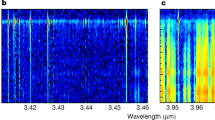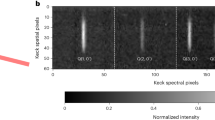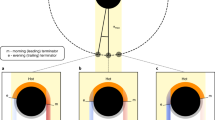Abstract
Mercury is the least studied of the terrestrial planets. Its interior and subsurface properties are still largely unknown. The subsurface can be probed at microwave frequencies where the electrical skin depth is ∼70 cm at 5 GHz1. Previous ground-based observations2,3 were unable to resolve details of Mercury's disk, and Mariner 10 did not carry a microwave radiometer. The Very Large Array (VLA) was used to make the first centimetre-wavelength interferometric observations that resolve the disk. We have mapped the distribution of total and polarized intensities from the planet's subsurface layers. We report the first detection of a hot pole along the hermean equator, which we model as black-body reradiation from preferential diurnal heating. These observations appear to rule out any internal sources of heat within Mercury. We also find polarized emission from the limb of the planet, which is understood in terms of the dielectric properties of the hermean surface.
This is a preview of subscription content, access via your institution
Access options
Subscribe to this journal
Receive 51 print issues and online access
$199.00 per year
only $3.90 per issue
Buy this article
- Purchase on Springer Link
- Instant access to full article PDF
Prices may be subject to local taxes which are calculated during checkout
Similar content being viewed by others
References
Baker, D. N., Borovsky, J. E., Bums, J. O., Gisler, G. R. & Zeilik, M. J. geophys. Res. 92, 4707–4712 (1987).
Cuzzi, J. N. Astrophys. J. 189, 577–586 (1974).
Golden, L. M. thesis, Univ. California, Berkeley (1977).
Thompson, A. R., Clark, B. G., Wade, C. M. & Napier, P. J. Astrophys. J. Suppl. Ser. 44, 151–167 (1980).
Astronomical Image Processing System (AIPS) (National Radio Astronomy Observatory, Green Bank, West Virginia, 1986).
Clark, B. G. Astr. Astrophys. 89, 377–378 (1980).
Morrison, D. Space Sci. Rev. 11, 271–307 (1970).
Cornwell, T. J. & Evans, K. F. Astr. Astrophys. 143, 77–83 (1985).
Morrison, D. Smithsonian astrophys. Obs., Spec. Rep. No. 292 (1969).
Jackson, J. D. Classical Electrodynamics 2nd edn section 7.3 (Wiley, New York, 1975).
Golden, L. M. Icarus 38, 451–455 (1979).
Author information
Authors and Affiliations
Rights and permissions
About this article
Cite this article
Burns, J., Gisler, G., Borovsky, J. et al. Radio-interferometric imaging of the subsurface emissions from the planet Mercury. Nature 329, 224–226 (1987). https://doi.org/10.1038/329224a0
Received:
Accepted:
Issue Date:
DOI: https://doi.org/10.1038/329224a0
Comments
By submitting a comment you agree to abide by our Terms and Community Guidelines. If you find something abusive or that does not comply with our terms or guidelines please flag it as inappropriate.



